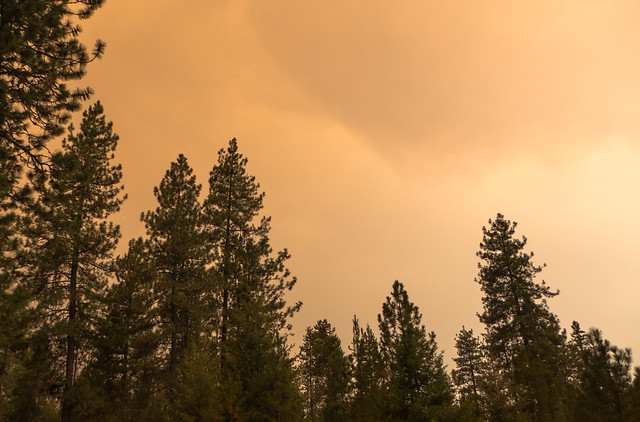
This essay has sat lurking in my head for weeks now, threatening to force me into verbally confronting a reality that has borne silent witness in the hot forest and the burning skies. Instead of writing, I chopped wood and stacked it and then retreated into the stale artificial coolness of my air-conditioned house. When it was cool enough outside, I carried my folding chair to shaded places between the trees and read my books.
As the summer wore on, the ground went dusty and the birds grew quiet. The rich smells of my living forest faded into the dessicated air.
Then the wildfires began. Plumes of smoke drifted in, for days and then weeks. I stayed inside, obsessively checking fire update pages on Facebook. I drew the shades and watched movies in the dark.
For the first time, I took to watering the century-old trees within reach of my well. It may save them, for this year at least, from the bark beetles whose white larvae wriggled around the scarred surface of firelogs I’d cut from their dead neighbors. Several times per day for weeks now, I’ve pounded holes into parched earth near trunks six feet around, shoving the end of a long hose down to dribble fifteen gallons per hour into the dirt around their stressed roots. I have borrowed nearly twenty thousand gallons from the acquifer beneath me to pay the balance due to old ponderosa pines that expect more than what the skies have given them this year.

Except for two tenths of an inch that fell one glorious day in July, it has not rained here since May. This summer has been hotter than these trees or I have ever experienced in these woods. And now they are burning, thousands of acres turned into smoke and ash, in all directions.
“Across the Northwest U.S., a region known for its damp climate, its rainforests, and for often cool and wet weather,” observes writer and outstanding climate blogger Robert Marston Fanney, “wildfires have been exploding. This summer, heat and dryness settled over the region in a months-long drought and heatwave.” And he adds something I’ve thought myself, having lived in Arizona for many years and now in Eastern Washington: “The climate of the Desert Southwest has been forced into Northern California, Oregon, Washington, and Montana.” 2
The forest floor is dry and gray and withered. Sad little clouds of dust stir up when I walk through it, coating pale stiff lichen and parched leaves of bearberry and Oregon grape. How much more of this can they take?
The closest fire to me, some twenty miles away, has scorched more than 40,000 acres. Meanwhile, Washington State has had over 280,000 acres burned out of its midsection from some giant fires that are still far from being contained. Considered together (though they have not yet merged, as of this writing), they form the largest wildfire in Washington state history. The previous record was set last year.3
Something is going terribly wrong.
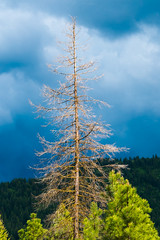
“Not even people who are preoccupied with climate change like to think about it anymore,” writes James Howard Kunstler in his excellent book Too Much Magic. “The more you explore the problem, the worse it seems and the more hopeless you feel.” 4
“The whole idea of climate change is so overwhelming, you want to tune it out,” agrees Ted McGregor, publisher of Spokane’s alt-weekly newspaper. “But this summer, the smokey skies won’t let us. It might seem like an insensitive time to inject politics, but we need to face facts.” 5
Those facts are daunting indeed. NOAA just reported that the “combined average temperature over global land and ocean surfaces for July 2015 was the highest for July in the 136-year period of record.” That’s 1.46°F higher than the 20th century average. The previous record was set in 1998.6
Unless greenhouse gas emissions are restrained, the next four decades are likely to move many parts of the planet to “a new, permanent heat regime in which the coolest warm-season of the 21st century is hotter than the hottest warm-season of the late 20th century.” 7 From this point on, we can expect about a third of the summers in the American West to be hotter than the hottest season we experienced between 1980-1999. By mid-century, most of them will be.8
That’s a drastic change for the climate of a big chunk of the United States. And as the following map shows (from NASA’s Goddard Institute for Space Studies), it’s one that’s been underway for some time now. For the past fifteen years, average July temperatures in the American West have been at least 1°F higher than they were between 1920-1980, perhaps nearly twice that.
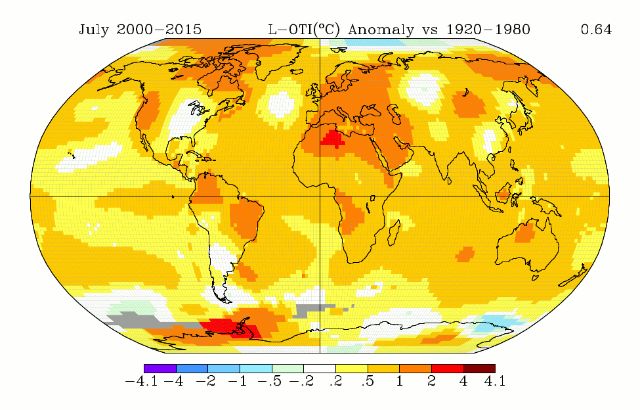
The Third National Climate Assessment, a report produced last year by more than 300 experts and “guided by a 60-member National Climate Assessment and Development Advisory Committee,” shows that much of the U.S.–not just the West–was more than 1°F hotter on average between 1991-2012 compared to 1901-1960.10 “Summers are longer and hotter,” the report notes, “and extended periods of unusual heat last longer than any living American has ever experienced.” And it speaks directly to what I’ve been seeing: “Hotter and drier weather and earlier snowmelt mean that wildfires in the West start earlier in the spring, last later into the fall, and burn more acreage.” 11
Where I live, it’s actually been worse than just earlier snowmelt: We got almost no snow to have melted this year. Another map from the Goddard Institute shows one reason why: Our winters are getting warmer, too.
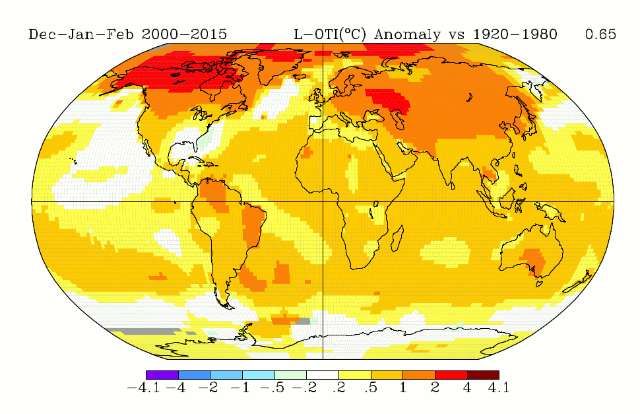
It does get cold here in the winter, with temperatures often in the teens and below. But that almost always happens under clear skies. When the clouds gather overhead and decide to dump some precipitation on us, temperatures are usually hovering right around the freezing mark.
One degree of average increase in that temperature can make for a lot more rain than snow. And it is snow, not rain, that remains on the shaded forest floor until March or even April in a slow melt that soaks the trees for a burst of bright green growth each spring.
We have been getting less of that sky water, lately, in either form. A so-called “ridiculously resilient ridge” of high pressure has parked itself off the West Coast for much of the past three years, keeping moisture-bearing storms from making landfall. Last year, a team of Stanford University scientists “used a novel combination of computer simulations and statistical techniques to show” that this high-pressure region “was much more likely to form in the presence of modern greenhouse gas concentrations.” 13 Their simulations came up with extreme high-pressure events significantly more often between a 1979-2005 interval compared to “pre-industrial” times, but only when “anthropogenic forcings” (greenhouse gas emissions) were included along with natural forcings. The “heightened probability cannot be explained without the anthropogenic contribution.” 14
It’s a significant, unprecedented weather event that we are witnessing right before our eyes. And the likely reason we are seeing it is that we’ve spent the past two centuries dumping the carbon that nature accumulated over nearly 500 million years into those skies.15 “This isn’t a projection of 100 years in the future,” says one of the Stanford scientists. “This is an event that is more extreme than any in the observed record, and our research suggests that global warming is playing a role right now.” 16
Given this, and with all the talk of present and future drought, I was surprised to see that the National Climate Assessment report actually predicts more precipitation for our region later in this century, between 10-20% more in fall, winter, and spring. More spring rain might helpful. But the summer forecast is a cruel one, calling for 20% less rain.17 That’s when the sap is really running and the trees are trying to use all the sunlight from endless days that barely dim, or to at least survive the blistering heat.
Still, for some reason, the report projects an increase of 1-5% in average soil moisture for my area by the middle of this century.18 I’ll take it, if that ridiculous ridge will just get out of the way.
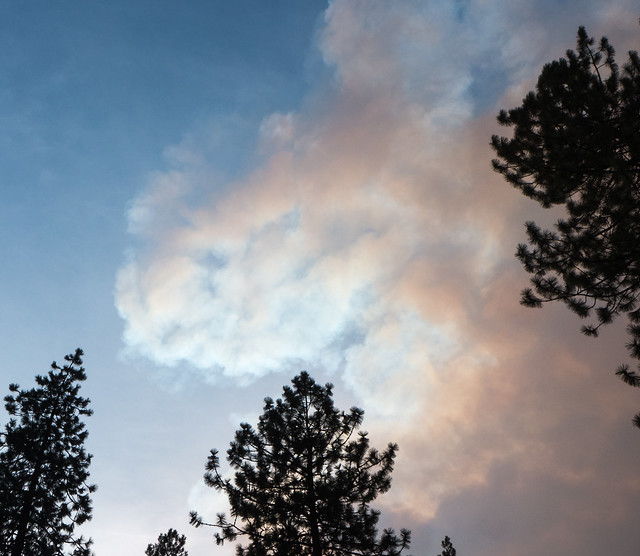
In his book Climate Wars, Gwynne Dyer offers four conclusions that he reached “after a year of trailing around the world of climate change.” First is that “this thing is coming at us a whole lot faster than the publicly acknowledged wisdom has it. When you talk to the people at the sharp end of the climate business, scientists and policy-makers alike, there is an air of suppressed panic in many of the conversations.” 19
Panic, and despair. You can feel it welling up from the scientists who were interviewed for John Richardson’s sobering article this summer in Esquire. One of them, Jason Box, is an outspoken climatologist who “escaped America’s culture of climate-change denial” by moving to Denmark. Now he tries not to talk about the magnitude of the problem because leaders of even that liberal country “still did not take kindly to one of its scientists distressing the populace with visions of global destruction.” He is thinking about a bug-out plan in Greenland, whose melting glaciers he studies.
“Among climate activists, gloom is building,” says Richardson, and then he lists some examples:
Jim Driscoll of the National Institute for Peer Support just finished a study of a group of longtime activists whose most frequently reported feeling was sadness, followed by fear and anger. Dr. Lise Van Susteren, a practicing psychiatrist and graduate of Al Gore’s Inconvenient Truth slide-show training, calls this “pretraumatic” stress. “So many of us are exhibiting all the signs and symptoms of posttraumatic disorder–the anger, the panic, the obsessive intrusive thoughts.” Leading activist Gillian Caldwell went public with her “climate trauma,” as she called it, quitting the group she helped build and posting an article called “16 Tips for Avoiding Climate Burnout” . . .
Anger is another of the emotions Dr. Box is dealing with. He has little patience for the climate-change denialists he says “are risking everyone’s future.” The Koch Brothers he calls “criminals” who “should be charged with criminal activity because they’re putting the profits of their business ahead of the livelihoods of millions of people, and even life on earth.” But he is relieved, at least, not to “have to bother with this bullshit anymore” in Denmark.20
Kunstler thinks it’s probably more accurate to call it reality denial. “It’s another of the universe’s jokes on us,” he adds, “that the humans who call themselves conservatives tend to be the most avid for squandering everything the planet affords us to live.” It’s more than politics, though. We just don’t want to face what we have done, and what’s in store for us. And that, says Kunstler,
has spawned a lively industry in climate change denial that is a wholly owned subsidiary of the oil, gas, and coal industries and a political subculture in its own right, aimed at defeating any policy consensus that would reduce the use (and sale) of oil, gas, and coal. Climate denial also happens to work nicely for that big chunk of the public at large that does not want to entertain any comprehensive change in the way we currently do things. And so the debate about what to do about climate change decays into incoherence as the deniers deliberately distort the facts while the science-minded are buffaloed by such mendacity and frustrated by a public that isn’t interested in the facts.21
I’m all too familiar with head-in-the-sand behavior, thanks to my studies of Christianity’s responses to evolution. Seeing such willful denial gets me angry, too, though I understand that there are many motivations for people to let themselves be misled. But, as William Catton observed 35 years ago, “real limits not seen are not limits repealed.” 22
I also acknowledge my own complicity. My flights to Hawaii and back, to snorkel among coral reefs that will likely all be dead before I am, have added hundreds of pounds of carbon to the skies. I eat meat and drive a car, and had children (quite a few, as it turned out) who now do the same. Richardson asks one of his climate scientists if he think it would be wrong to take a transatlantic flight for his interviews. (Unlike Al Gore with his private jet, Richardson appears to have a healthy dislike for hypocrisy.) The scientist laughs and replies, “You have to answer that yourself.”
Perhaps there is some cold comfort for our collective guilt in Dyer’s second conclusion: Everyday lifestyle changes like changing light bulbs and reduced driving are “practically irrelevant to the outcome of this crisis.” Without “zero greenhouse-gas emissions globally by 2050 and, preferably, 80 per cent cuts by 2030,” we are in for a very rough ride. His third conclusion? That ain’t gonna happen. “Maybe if we had gotten serious about climate change fifteen years ago, or even ten, we might have had a chance, but it’s too late now.”

It is already too late for the Colorado forests that Dr. Box left behind. They “are dying,” he says, “and they will not return. The trees won’t return to a warming climate. We’re going to see megafires even more, that’ll be the new one–megafires until those forests are cleared.” I look around at the green landscape that I cherish, sullied by smoke for weeks now, and wonder. Will my trees also die, and not return?
Dyer’s fourth conclusion is that “mass movements of population, the number of failed and failing states, and very probably the incidence of internal and international wars” are correlated with increased global temperature. There is an important point to this: International mayhem from failed states and wars, “if they become big and frequent enough, will sabotage the global cooperation that is the only way to stop the temperature from continuing to climb.” 23 This is a geopolitical positive feedback mechanism, one involving human behavior: Bad may prevent the prevention of worse.
Positive feedback is what makes the PA system squeal when a microphone gets too close. Something about the current output of a system causes future outputs to increase even more. There are natural positive feedbacks to the global climate system, too, and they are scary because they are completely out of our control. Once we have dumped the carbon dioxide from our planes and cars and the methane from our cows’ burps and farts (seriously, they are an issue), the resulting rise in temperatures “feed back” in various ways to make temperatures rise even faster.

That’s why increases in temperature are so dangerous even though they look small as mere numbers–unless you are sweating out a hot summer or wondering why it hardly snows anymore. “So far we’ve been the cause for the sudden surge in greenhouse gases and hence global temperatures,” says Bill McKibben,
but that’s starting to change, as the heat we’ve caused has started to trigger a series of ominous feedback effects. Some are fairly easy to see: melt Arctic sea ice, and you replace a shiny white mirror that reflects most of the incoming rays of the sun back out to space with a dull blue ocean that absorbs most of those rays. Others are less obvious, and much larger: booby traps, hidden around the world, waiting for the atmosphere to heat.
The biggest of those booby traps is found in the ground and under the seas of the Arctic, which is warming faster than any part of the planet. There are “immense quantities of methane natural gas locked up beneath the frozen tundra, and in icy ‘clathrates’ beneath the sea. Methane, like carbon dioxide, is a heat-trapping gas; if it starts escaping into the atmosphere, it will add to the pace of warming.” And it is doing just that. “In 2007, atmospheric levels of methane began to spike.” 25
“Arctic permafrost ground that has been frozen for many thousands of years is now thawing because of global climate change, and the results could be disastrous and irreversible,” warns the Woods Hole Research Center. It’s releasing not just methane but also carbon dioxide. And then, after these additional greenhouse gases have been added to what we are continuing to dump into the atmosphere, you can guess what happens: The temperature goes up faster still. There is an acceleration of climate change, “which in turn causes more thawing of the permafrost. This potentially unstoppable and self-reinforcing cycle could constitute a calamitous ‘tipping point.’” 26
Another example: The forests and oceans are getting less efficient as carbon sinks as we add more carbon.27 The trees are stressed from heat and drought. Millions of them are getting killed off by bark beetles that aren’t being controlled by cold enough winters or the trees’ natural defenses.
We started this mess in just the past century, mostly, when we began extracting and burning fossil fuels. Once the temperature had gone up enough, the feedback mechanisms got established. Now, the freight train is moving down the tracks, heading downhill, and it’s getting away from us. We’re not even trying to slow it down; we just continue to add more and more carbon, faster than ever. Drill, baby, drill.
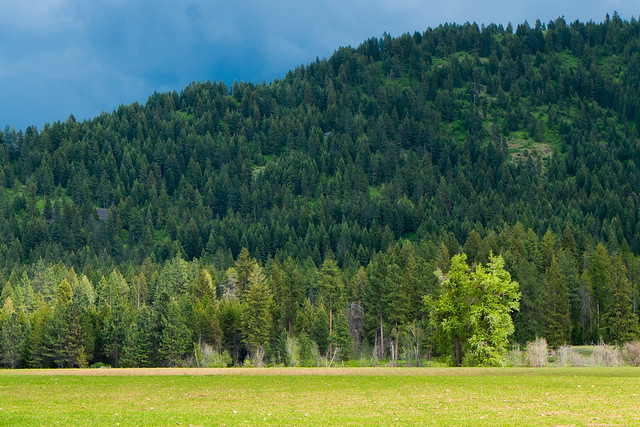
After attending a community meeting a few days ago about the monster of a fire near us, I realized that yet another nasty feedback mechanism is at work in the forests of Eastern Washington. It involves bad consequences of over-stressed resources, system collapse.
When lightning sparked a small fire in the Huckleberry mountains west of here, thousands of acres were already burning to the north. Our local fire chief had lent out resources for other fire districts to help fight those. That’s just what you do. It was a terrible night, with dry lightning sparking fires seemingly all around us and then strong winds fanning the flames.
Unfortunately, when yet another chief called him for help with a few acres burning in the Huckleberry Mountains, he was forced to decline. It pained him to do that, he said, both personally and professionally, but there was no choice. He couldn’t leave his own fire district defenseless, especially on such a night as that. The whole state–indeed the entire American West–was stretched to the breaking point. Yet if he had been able to answer that call, the fire might have been stopped with just dozens of acres burned instead of thousands.
And so another tipping point was reached. The local fire fighting system was overwhelmed and the Carpenter Road fire has burned forty thousand acres of forest near our home. What else is in store for us, this year, and next year, and the one after that?
It’s stressful enough just thinking about next week. Despite aggressive efforts and over four hundred personnel working the fire, the monster has just jumped its main fire line, Springdale-Hunters Road. And there is yet another “red flag warning” heading our way tomorrow. “CRITICAL FIRE WEATHER CONDITIONS ARE LIKELY,” shouts the all-caps message from the National Weather Service. “A COMBINATION OF GUSTY WINDS, LOW RELATIVE HUMIDITY, AND WARM TEMPERATURES WILL CREATE HIGH FIRE GROWTH POTENTIAL.”
They might as well just extend a red flag warning to the entire planet, from this point on.
Notes
-
From ncdc.noaa.gov/temp-and-precip/state-temps. In fairness, it’s worth noting that the maximum summertime temperatures, while also on an upward trend over the past forty years, experienced anomalously high values averaged over the years 1920-1930, and that there were two very hot years way back around 1960. As with the prediction of higher soil moisture in my area, such isolated records of previous hot weather are hopeful little islands in a sea of awful upward trends. ↩
-
“US Experiencing Worst Fire Season on Record as Blazes in Washington and Oregon Explode Twelvefold to Over 1 Million Acres,” robertscribbler blog, August 24, 2015 posting. ↩
-
The Carpenter Road fire started by a half-dozen or so lightning strikes near Fruitland, WA and was quickly fanned by high winds into a monster that raised evacuation alerts just miles away from my home. This information comes from an information meeting I attended at the local Grange hall. Regarding the other, larger fire, see en.wikipedia.org/wiki/Okanogan_Complex_fire. As of this writing, the “Okanogan Complex fire has not merged into a single fire,” so, technically, last year’s “Carlton Complex remains the state’s largest single fire.” ↩
-
James Howard Kunstler, Too Much Magic: Wishful Thinking, Technology, and the Fate of the Nation. (Grove/Atlantic, 2012), Kindle loc. 3185. ↩
-
“The New Normal,” Publisher’s Note, The Inlander (Aug. 19, 2015), inlander.com/spokane/the-new-normal/Content?oid=2540653. ↩
-
National Oceanic and Atmospheric Adminisration, Global Analysis–July 2015, ncdc.noaa.gov/sotc/global/201507. It gets worse: “As July is climatologically the warmest month of the year globally, this monthly global temperature of 16.61°C (61.86°F) was also the highest among all 1627 months in the record that began in January 1880.” As you might expect from that, the trend doesn’t look good: “The July temperature is currently increasing at an average rate of 0.65°C (1.17°F) per century.” ↩
-
Noah S. Diffenbaugh and Martin Scherer, “Observational and model evidence of global emergence of permanent, unprecedented heat in the 20th and 21st centuries.” Climatic Change (Springer, 2011), No. 107, pp. 615-624. Accessible online at link.springer.com/article/10.1007/s10584-011-0112-y. ↩
-
These predictions are drawn from the climate modeling maps shown in Fig. 1 on p. 618 of Diffenbaugh and Scherer. ↩
-
Generated from an interactive web page hosted by NASA’s Goddard Institute for Space Studies. Earlier this year, the Institute “was threatened with 30 percent budget cuts by Republicans who resent its reports on climate change” (John H. Richardson, Esquire, Jul. 7, 2015). ↩
-
Jerry M. Melillo, Terese (T.C.) Richmond, and Gary W. Yohe, Eds., Climate Change Impacts in the United States: The Third National Climate Assessment. U.S. Global Change Research Program, doi:10.7930/J0Z31WJ2, Fig. 2.7 (p. 29). PDF available at nca2014.globalchange.gov/downloads. ↩
-
Melillo et al., p. 1. ↩
-
Generated from the Goddard Institute interactive web page for Northern Hemisphere winter, with a time interval of 2000-2015 and a base period of 1920-1980. ↩
-
Ker Than, “Causes of California drought linked to climate change, Stanford scientists say,” Stanford Report (Sept. 30, 2014), news.stanford.edu/news/2014/september/drought-climate-change-092914.html ↩
-
Daniel L. Swain, et al., “The Extraordinary California Drought of 2013/14: Character, Context, and the Role of Climate Change,” special supplement to the Bulletin of the American Meteorological Society (Vol. 95, No. 9, Sept. 2014), journals.ametsoc.org/doi/suppl/10.1175/1520-0477-95.9.S1.1/suppl_file/10.1175_1520-0477-95.9.s1.3.pdf ↩
-
Kunstler, loc. 3278. ↩
-
Noah Diffenbaugh, quoted in Than, Stanford Report. ↩
-
Melillo, et al. (Fig. 2.14, p. 34). ↩
-
Melillo, et al. (Fig. 2.22, p. 41). See also Kunstler, loc. 3366 (“Rainfall over landmasses has increased by about 2 percent through the twentieth century. Global warming increases the evaporation of moisture from oceans. It eventually precipitates out as rain or snow”). ↩
-
Gwynne Dyer, Climate Wars: The Fight for Survival as the World Overheats (Oneworld Publications, 2010), loc. 112. ↩
-
John H. Richardson, “When the End of Human Civilization Is Your Day Job,” Esquire (July 7, 2015), esquire.com/news-politics/a36228/ballad-of-the-sad-climatologists-0815 ↩
-
Kunstler at loc. 3221, 3490. ↩
-
Willam R. Catton, Overshoot: The Ecological Basis of Revolutionary Change. Urbana and Chicago: University of Illinois Press (1982). ↩
-
Dyer at loc. 121. ↩
-
Graph from climate.nasa.gov/climate_resources/24. Regarding the “hockey stick,” see Richardson’s Esquire article: Mann “was a young Ph.D. researcher when he helped come up with the historical data that came to be known as the hockey stickthe most incendiary display graph in human history, with its temperature and emissions lines going straight up at the end like the blade of a hockey stick. He was investigated, was denounced in Congress, got death threats, was accused of fraud, received white powder in the mail, and got thousands of e-mails with suggestions like, You should be “shot, quartered, and fed to the pigs along with your whole damn families.” Conservative legal foundations pressured his university, a British journalist suggested the electric chair. In 2003, Senator James Inhofe’s committee called him to testify, flanking him with two professional climate-change deniers, and in 2011 the committee threatened him with federal prosecution, along with sixteen other scientists. ↩
-
Bill McKibben, Eaarth: Making a Life on a Tough New Planet, Henry Holt and Co. (2010), p. 20. ↩
-
“U.S. scientists warn leaders of dangers of thawing permafrost,” Woods Hole Research Center, Aug. 27, 2015. whrc.org/u-s-scientists-warn-leaders-of-dangers-of-thawing-permafrost. ↩
-
McKibben at p. 22. ↩




